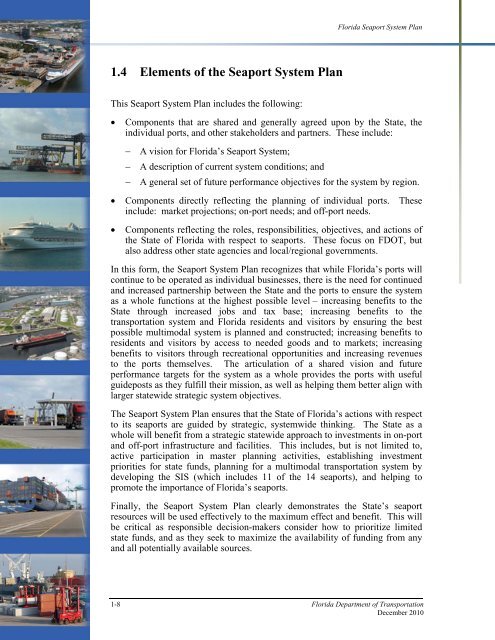Florida Seaport System Plan - SeaCIP
Florida Seaport System Plan - SeaCIP
Florida Seaport System Plan - SeaCIP
Create successful ePaper yourself
Turn your PDF publications into a flip-book with our unique Google optimized e-Paper software.
<strong>Florida</strong> <strong>Seaport</strong> <strong>System</strong> <strong>Plan</strong><br />
1.4 Elements of the <strong>Seaport</strong> <strong>System</strong> <strong>Plan</strong><br />
This <strong>Seaport</strong> <strong>System</strong> <strong>Plan</strong> includes the following:<br />
• Components that are shared and generally agreed upon by the State, the<br />
individual ports, and other stakeholders and partners. These include:<br />
− A vision for <strong>Florida</strong>’s <strong>Seaport</strong> <strong>System</strong>;<br />
− A description of current system conditions; and<br />
− A general set of future performance objectives for the system by region.<br />
• Components directly reflecting the planning of individual ports. These<br />
include: market projections; on-port needs; and off-port needs.<br />
• Components reflecting the roles, responsibilities, objectives, and actions of<br />
the State of <strong>Florida</strong> with respect to seaports. These focus on FDOT, but<br />
also address other state agencies and local/regional governments.<br />
In this form, the <strong>Seaport</strong> <strong>System</strong> <strong>Plan</strong> recognizes that while <strong>Florida</strong>’s ports will<br />
continue to be operated as individual businesses, there is the need for continued<br />
and increased partnership between the State and the ports to ensure the system<br />
as a whole functions at the highest possible level – increasing benefits to the<br />
State through increased jobs and tax base; increasing benefits to the<br />
transportation system and <strong>Florida</strong> residents and visitors by ensuring the best<br />
possible multimodal system is planned and constructed; increasing benefits to<br />
residents and visitors by access to needed goods and to markets; increasing<br />
benefits to visitors through recreational opportunities and increasing revenues<br />
to the ports themselves. The articulation of a shared vision and future<br />
performance targets for the system as a whole provides the ports with useful<br />
guideposts as they fulfill their mission, as well as helping them better align with<br />
larger statewide strategic system objectives.<br />
The <strong>Seaport</strong> <strong>System</strong> <strong>Plan</strong> ensures that the State of <strong>Florida</strong>’s actions with respect<br />
to its seaports are guided by strategic, systemwide thinking. The State as a<br />
whole will benefit from a strategic statewide approach to investments in on-port<br />
and off-port infrastructure and facilities. This includes, but is not limited to,<br />
active participation in master planning activities, establishing investment<br />
priorities for state funds, planning for a multimodal transportation system by<br />
developing the SIS (which includes 11 of the 14 seaports), and helping to<br />
promote the importance of <strong>Florida</strong>’s seaports.<br />
Finally, the <strong>Seaport</strong> <strong>System</strong> <strong>Plan</strong> clearly demonstrates the State’s seaport<br />
resources will be used effectively to the maximum effect and benefit. This will<br />
be critical as responsible decision-makers consider how to prioritize limited<br />
state funds, and as they seek to maximize the availability of funding from any<br />
and all potentially available sources.<br />
1-8 <strong>Florida</strong> Department of Transportation<br />
December 2010
















